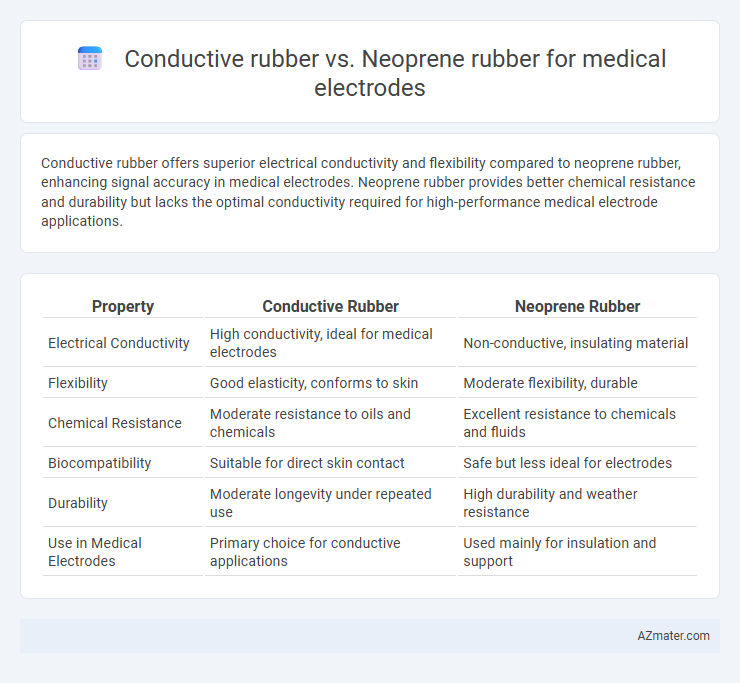Conductive rubber offers superior electrical conductivity and flexibility compared to neoprene rubber, enhancing signal accuracy in medical electrodes. Neoprene rubber provides better chemical resistance and durability but lacks the optimal conductivity required for high-performance medical electrode applications.
Table of Comparison
| Property | Conductive Rubber | Neoprene Rubber |
|---|---|---|
| Electrical Conductivity | High conductivity, ideal for medical electrodes | Non-conductive, insulating material |
| Flexibility | Good elasticity, conforms to skin | Moderate flexibility, durable |
| Chemical Resistance | Moderate resistance to oils and chemicals | Excellent resistance to chemicals and fluids |
| Biocompatibility | Suitable for direct skin contact | Safe but less ideal for electrodes |
| Durability | Moderate longevity under repeated use | High durability and weather resistance |
| Use in Medical Electrodes | Primary choice for conductive applications | Used mainly for insulation and support |
Introduction to Medical Electrodes
Medical electrodes require materials with excellent conductivity and biocompatibility to ensure accurate bio-signal detection and patient safety. Conductive rubber offers superior electrical conductivity and flexibility, making it ideal for stable skin contact in medical electrodes, while neoprene rubber provides durability and chemical resistance but lower conductivity. Selection depends on specific medical device requirements, with conductive rubber often preferred for enhanced signal quality in bioelectrical monitoring.
Overview of Conductive Rubber
Conductive rubber, commonly made from silicone or natural rubber blended with conductive fillers like carbon black or silver particles, offers exceptional flexibility and reliability for medical electrodes, ensuring precise bio-signal transmission. Its low electrical resistance and biocompatibility make it ideal for long-term patient monitoring and electrotherapy applications. Compared to neoprene rubber, which primarily focuses on insulation and durability, conductive rubber prioritizes electrical conductivity, crucial for maintaining consistent electrode performance.
Overview of Neoprene Rubber
Neoprene rubber is widely used in medical electrodes due to its excellent chemical stability, flexibility, and resistance to oil, heat, and weathering. Its inherent electrical insulation properties make it a reliable base material that can be enhanced with conductive fillers to improve conductivity for electrode applications. Compared to conductive rubber, neoprene offers superior durability and biocompatibility, making it ideal for prolonged skin contact in medical devices.
Electrical Conductivity Comparison
Conductive rubber exhibits significantly higher electrical conductivity than neoprene rubber, making it the preferred choice for medical electrodes where precise signal transmission is crucial. The carbon or metal fillers within conductive rubber create efficient pathways for electron flow, outperforming neoprene's inherently insulating polymer matrix. This enhanced conductivity ensures more accurate biopotential measurements and reliable electrode-skin interface performance in medical monitoring devices.
Biocompatibility and Safety
Conductive rubber offers excellent biocompatibility and low cytotoxicity, making it suitable for prolonged skin contact in medical electrode applications, while neoprene rubber may cause allergic reactions due to its chemical additives. Safety profiles favor conductive rubber as it minimizes skin irritation and supports stable electrical conductivity, crucial for accurate bio-signal monitoring. The inherent properties of conductive rubber ensure better patient comfort and reduced risk of sensitization compared to neoprene, which can degrade and release irritants over time.
Durability and Flexibility
Conductive rubber offers superior flexibility and enhanced durability, making it ideal for medical electrodes requiring repeated mechanical stress and consistent signal transmission. Neoprene rubber provides excellent chemical resistance and moderate durability but tends to be less flexible over extended use in medical applications. For long-term electrode performance, conductive rubber ensures greater resilience and maintains optimal conductivity under frequent bending and compression.
Ease of Fabrication and Customization
Conductive rubber offers superior ease of fabrication and customization for medical electrodes due to its inherent electrical properties and flexibility in molding processes, enabling precise adjustments to shape and conductivity. Neoprene rubber, while durable and resistant to environmental factors, presents challenges in customization because it requires additional conductive fillers or coatings to achieve electrical conductivity, complicating the manufacturing process. Therefore, conductive rubber provides more efficient production workflows and tailored solutions essential for high-performance medical electrode applications.
Cost Considerations
Conductive rubber offers higher upfront material costs compared to neoprene rubber but provides superior electrical conductivity essential for medical electrode performance. Neoprene rubber, being more economical and widely available, reduces production expenses but may require additional conductive coatings to meet electrode functionality, potentially increasing long-term costs. Evaluating total cost of ownership involves balancing initial investment with performance requirements and durability in medical applications.
Typical Applications in Medical Devices
Conductive rubber is widely used in medical electrodes for its excellent electrical conductivity, flexibility, and skin compatibility, making it ideal for ECG, EEG, and TENS devices where precise signal transmission is critical. Neoprene rubber, known for its durability, chemical resistance, and insulation properties, is often employed in protective insulating components of medical devices but is less preferred for direct electrode contact. Typical applications favor conductive rubber in wearable biosensors and diagnostic equipment, while neoprene serves in device housings and environmental seals in medical technology.
Choosing the Right Rubber for Medical Electrodes
Conductive rubber offers superior electrical conductivity and biocompatibility, making it ideal for precise medical electrode applications requiring consistent signal transmission. Neoprene rubber provides excellent chemical resistance and durability but has lower conductivity, suitable for protective housings rather than signal interface components. Selecting the right rubber depends on prioritizing electrical performance in conductive rubber or mechanical protection in neoprene for optimal medical electrode function.

Infographic: Conductive rubber vs Neoprene rubber for Medical electrode
 azmater.com
azmater.com